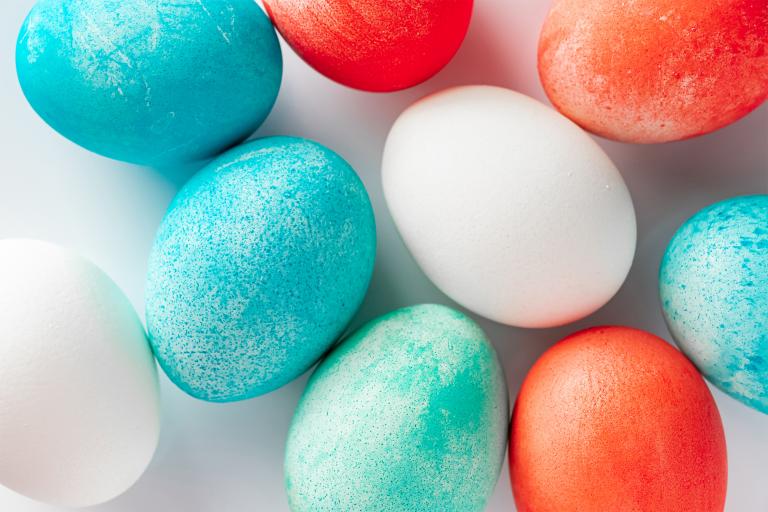Was Walnüsse, Zwiebeln und Kaffeesatz mit Ostern zu tun haben
Diese Woche feiern wir Ostern und das bedeutet für die meisten von uns, dass am Sonntag ein herzhaftes Frühstück mit Eiern auf uns wartet. Ob es nun die Auferstehung Jesu Christi, der Neubeginn, das Ende der Fastenzeit oder der Frühlingsbeginn ist, auf den wir anstoßen, die bunt gefärbten Eier gehören einfach dazu. Woher genau die Tradition des Eierfärbens stammt, ist nicht ganz klar, aber es ist bekannt, dass die Menschen im Mittelalter während der Fastenzeit Eier hart gekocht haben, damit sie nicht verderben und sie mit Zwiebelschalen oder Roter Bete färbten, um sie von frischen Eiern zu unterscheiden.
Heute werden Ostereier in der Industrie oft mit synthetischen Substanzen wie Azofarbstoffen gefärbt, abgesehen von Bio-Eiern, die nur mit natürlichen Farbstoffen und auch nur während der Osterzeit gefärbt werden dürfen. Zu den natürlichen Farbstoffen zählt neben verschiedenen Pflanzen wie Krapp, Färberkamille, Blauholz und Ringelblumen vor allem eine große Auswahl an färbenden Lebensmitteln. Für grüne Färbungen kann zum Beispiel Spinat oder Petersilie verwendet werden, für rote Färbungen Rote Bete, für Blau- oder Lilatöne Rotkohl und für gelbe Nuancen Karotten, Kurkuma oder Kümmel. Natürlich ist diese Auswahl nur ein kleiner Teil der ganzen Liste, auf der auch Tomaten, Trauben, Paprika und viele weitere Lebensmittel stehen.
Um aus den Lebensmitteln einen Farbstoff zu gewinnen, können sie zum Beispiel ausgekocht werden, denn der zurückbleibende Sud hat färbende Eigenschaften. Je länger die Kochzeit und der Kontakt zum Ei, desto intensiver die Farbe. Die Eier können während des Färbevorgangs gekocht werden, aber die Farbintensität lässt sich gezielter bestimmen, wenn die Eier vorgekocht sind, da sie in dem Zustand nur so lange in dem Sud eingelegt werden, wie sie brauchen um die gewünschte Farbintensität zu erhalten. In dem Fall kann auch bereits erkalteter Sud genutzt werden. Der Farbstoff kann aber auch mit Lösungsmitteln wie Aceton oder Methanol extrahiert werden.
Für die Farbstoffgewinnung eignen sich die Lebensmittel auch dann noch, wenn sie nicht mehr ganz frisch sind. So könnten unter anderem eingetrocknete Zwiebeln oder Gemüse mit kleinen Schönheitsmakeln, welches entsorgt wird, noch bevor es in den Handel kommt, vor dem Müll gerettet werden.
Wir haben in unserem Magazin schon oft geäußert, dass wir nicht nur die Lebensmittelverschwendung reduzieren, sondern auch Reststoffe, die lange keinen ersichtlichen Nutzen hatten, einem neuen Zweck zuführen möchten.
Deshalb möchten wir im Folgenden auf Reststoffe eingehen, die aufgrund ihrer färbenden Eigenschaften als Färbemittel eingesetzt werden können.

Walnussschalen
Mitte Februar haben wir Ihnen die zahlreichen
Anwendungsmöglichkeiten der Walnussschalen vorgestellt. Der Farbstoff “Juglon”, welcher in der äußeren grünen Fruchtschale enthalten ist, kann nicht nur Stoffe, sondern auch die Schale von Eiern in verschiedenen Brauntönen färben. Damit das Färbemittel das ganze Jahr über genutzt werden kann, werden die Schalen getrocknet oder zu Pulver gemahlen.
Kaffeesatz
Kaffeesatz, der nach der Zubereitung von Kaffee übrig bleibt und in großen Mengen im Müll landet, kann als Färbemittel für Ostereier dienen. Er erzeugt einen hellbraunen Farbton, der dem von braunen Eiern ähnelt, weshalb weiße Eier benutzt werden sollten. Es ist aber auch möglich, den Kaffeesatz gemeinsam mit roten Zwiebelschalen aufzukochen, welche dem Sud eine intensivere, dunklere Farbe verleihen. So können sogar dunkle, schokoladenbraune Farbtöne entstehen. Weiter innovative Einsatzmöglichkeiten von Kaffeesatz finden sie in unserem Artikel über
Innovative Produkte aus recyceltem Kaffee.
Zwiebelschalen
Bereits im Mittelalter haben die Menschen Eier mit Zwiebelschalen gefärbt. Zwiebelschalen können nicht nur als Ergänzung für einen Sud aus Kaffeesatz dienen, sondern auch unabhängig als Färbemittel eingesetzt werden. Dafür eignen sich sowohl rote als auch gelbe Zwiebelschalen. Rote Schalen erzeugen wie zu erwarten rote Farbtöne und die Palette von gelben Zwiebelschalen reicht von Gelb über Orange bis hin zu Braun.
Damit die natürlichen Farben besonders gut an den Eiern haften, kann dem gewonnenen Farbstoff Essig beigefügt werden: Eierschalen haben eine poröse Oberfläche, d. h. sie sind mit Poren durchsetzt, in denen sich die Farbpartikel festsetzen. Wird dem natürlichen Farbstoff etwas Essig oder eine andere Säure zugesetzt, werden die Farben intensiver, da die Säure das Calciumcarbonat, aus dem die Schale zu großen Teilen besteht, leicht auflöst und so die Oberfläche vergrößert. Dabei sollte aber beachtet werden, dass ein zu hoher pH-Wert negative Auswirkungen hat. Wird zum Beispiel reiner Essig mit einem pH-Wert von 3 verwendet, reagiert er mit dem Calciumcarbonat zu Kohlenstoffdioxid, welches sich in der Form von Bläschen von der Schale löst und eine gleichmäßige Färbung der Schale verhindert. Im Extremfall kann sich die Schale sogar ganz auflösen, da das Calciumcarbonat während dieser Reaktion verbraucht wird.
Ostern zeigt uns, dass die Kreislaufwirtschaft in verschiedenste Aspekte unseres Alltags integriert werden kann. Selbst das Färben von Eiern kann nachhaltig gestaltet werden und einen Beitrag zur Reduzierung von Lebensmittelverschwendung leisten.
.png)
In den nächsten Monaten werden wir Ihnen in LEROMAs Magazin weiterhin alternative Anwendungsbereiche von natürlichen Rohstoffe und Reststoffe vorstellen. Rohstoffe können zu Färbemitteln, Geschmacksverstärkern, Verdickungsmitteln oder sogar zu natürlichem Granulat für die Reinigungsindustrie oder zu einem kostengünstigen Füllmittel verarbeitet werden. Außerdem wird demnächst ein Artikel erscheinen, der sich intensiver mit
natürlichen Färbemitteln befasst, die in der Lebensmittelbranche eingesetzt werden können.
Wir wünschen Ihnen frohe Ostertage und laden Sie herzlich ein auch nächste Woche einen Blick in unser Magazin zu werfen.
Let’s simplify the future of change!


.png)


.png)